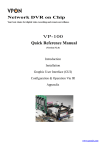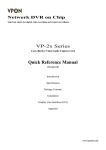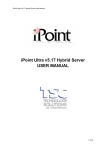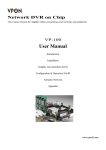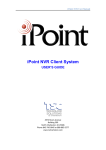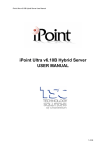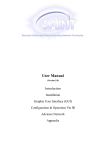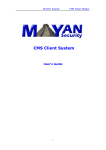Download MSI 865PE Neo3-F User manual
Transcript
iPoint NVR v5.16 Server User Manual iPoint NVR Server v5.16 USER MANUAL 1 iPoint NVR v5.16 Server Manual Table of Contents iPoint NVR Server v5.16 .................................................................................................................................... 1 USER’S GUIDE..................................................................................................................................................... 1 1. Introduction.......................................................................................................................................................... 3 2. DVR Server ......................................................................................................................................................... 4 2.1 Start Up ...................................................................................................................................................... 4 2.2 Main Interfaces .......................................................................................................................................... 5 2.2.1 Interface Description....................................................................................................................... 5 2.2.2. Instant playback recording files in the current window ............................................................... 13 2.3 System Configuration: ............................................................................................................................. 13 2.3.1. System Set-Up ............................................................................................................................. 14 2.3.2. Camera Setup ............................................................................................................................... 17 2.3.3. Sensor Set-Up .............................................................................................................................. 21 2.3.4. PTZ & Linkage Setup .................................................................................................................. 22 2.3.5. Send Email Setup......................................................................................................................... 25 2.3.6. Digital Matrix Setup .................................................................................................................... 26 2.3.7. System User Set-Up..................................................................................................................... 27 2.4. System Playback ..................................................................................................................................... 29 2.4.1 Enter Play Back Mode: ................................................................................................................. 29 2.4.3 Capture Pictures ............................................................................................................................ 32 2.4.4 Create Clip File ............................................................................................................................. 32 2.4.5 Search Captured Pictures .............................................................................................................. 35 2.4.6 Fast Search .................................................................................................................................... 37 2.4.7 Camera State ................................................................................................................................. 38 2.4.8 Showing files ................................................................................................................................ 39 Appendix A .................................................................................................................................................... 39 2 iPoint NVR v5.16 Server Manual 1. Introduction Thank you for purchasing the iPoint NVR system. This operation manual was created to help you quickly and efficiently install the NVR system and its most commonly used features. It is important to go through this manual, follow each step in order. Read the instructions carefully to ensure proper programming of the NVR system. Note: Please set the screen area as 1024x768 pixels before using this system. System features • • • • • • • • • • • • • • • • • • • Hardware support H.264 compression, low HDD cost Web access through LAN or WAN. Real time full-motion video-capture & display (Max. 48 channel video input) Real time high-speed recording: Max. 30 frames/sec per channel Synchronous audio recording (optional) Motion detecting (Whole area or max. 12 detection zones per channel) Normal recording (continuous) and event recording (Motion detection or external sensor) Electron Map pop-up when alarming System operating and alarm logging Alarm-before recording Remote recording Alarm message auto-sending Alarm image auto-sending to email box as attachment Matrix display and group display Duplex mode (Recording while playback) Network support (Remote access via LAN, Ethernet, PSTN, ISDN, ADSL) P/T/Z/F & speed dome control on keyboard Search/playback by date/time directory (random-access) Remote talking between server and client or server and server Recommended System Requirements • • • • Chipset: Intel 845PE, 865PE, 875PE, 915P Motherboard: Intel: D915PCY, D865PERL Asus: P4P800SE, P5P800 MSI: 865PE Neo2-F, 865PE Neo3-F Gigabit: GA-8PE667, Ultra2 GA-8IPE1000PRO Video Card: ATI Radeon 9250 128MB ATI Radeon 9550 128MB nVidia GeForce 6200 128MB nVidia GeForce 6600 128MB • Processor: Intel Pentium 4 2.4GHz or better • Memory: 512MB minimum Recommendations For optimal performance of your system, it is important to follow these recommendations. 1) Divide your hard disk into two at least two partitions (such as C: and D:). One partition is for installing Windows OS and system software, the other for storing record files. 2) Please use appropriate motherboard and display card. 3 iPoint NVR v5.16 Server Manual 2. DVR Server 2.1 Start Up Before you press the NVR power button, please check that all connection interfaces are firmly connected. Press the NVR system power button, then the application interface will display later (the time will be decided by how many channels the system has installed, each channel needs about 4-5 seconds). on windows If NVR Autostart has been deleted from start up please double click icon desktop. The main application interface is as follows: 1 2 9 10 11 12 13 16 8 Figure1-1-1 *Note: If this is the first time the system is run after installation, the operator should setup the resolution of the compression card. 4 iPoint NVR v5.16 Server Manual Figure1-1-2 2.2 Main Interfaces *Show Tips: When the mouse moves close to or stops on a button, the button function text tip will show immediately. *Full Screen Mode: Right click mouse button, a menu pops up, select “full screen”, change display mode to full screen (or press F12 on the keyboard). *Zoom In/Out Video Image: Double click the left mouse button on a camera window, zoom in/out video image (or press F11 on the keyboard). *Recording Status: a. This icon means the system is recording normally. b. This icon means the system is recording manually. c. This icon means the system is recording in motion detect. 2.2.1 Interface Description 1). OSD: Displays the On Screen Display including the current date, time and the camera name. This information will be watermarked on the recorded files. 2). Version Information: Version of the NVR Software. (v5.16) 3). Color Adjust: Slider adjustments for the video image and recording volume of the selected file. This also affects the live view of the video images. 5 iPoint NVR v5.16 Server Manual Increase Decrease Figure 1-2-1 ①② ③ ④ ⑤ 1 2 3 4 5 Allows user to adjust image brightness Allows user to adjust image contrast Allows user to adjust image hue Allows user to adjust image saturation Allows user to adjust audio 4). PTZ Control: By pressing and holding these buttons, the PTZ camera will be moved up, down, right and left as well quadrants in between. Auto Pan: Pressing this button initiates an automatic tour of all preset positions by the connected PTZ camera. Preset zone Adjust the speed of speed domes here. Numeric Panel Go button (Call out) Set button (Save preset) Camera address input field Figure1-3-1 6 iPoint NVR v5.16 Server Manual Relay (on/off): Controls the PTZ cameras internal relay (relay1), or the decoders relay (relay1) Used to turn on a light or control an access gate. Wiper (on/off): Using the PTZ cameras corresponding wiper control relay, this toggles the relay/wiper on and off Zoom +, Zoom- : Controls the zoom function of the PTZ camera. Focus +, Focus-: Overrides the auto-focus setting of the PTZ camera, adjusts focus of the image. Iris+, Iris- : Overrides the PTZ cameras auto-iris and brightens or darkens the image. Setup: Set the speed by moving speed domes to desired place. Input the address in address space (take 3 as an example here). Finally press the SET button and the pointer will be bright for 3 seconds while programming. Set others in the same way. Delete Preset: Click “-” button, select preset number from numeric panel, then click the SET button. Preset: If preset number is less than16, click its number button in PRESET ZONE. If preset number is more than 17, call out by clicking number button then click GO. Auto tracking along with all preset. Start tracking: In numeric panel, click the “-, + number” (this number is the interval of every preset), then click GO. Stop Tracking: In preset zone, click any preset number, then click GO. NOTE: You can also control the PTZ image from the Main Screen of the NVR Software. Figure1-2-3 Shown in image #3, each rectangle is the effective action. Arrows denote the direction of the action. Press and hold down the mouse in a corresponding area, this will control the PTZ. 7 iPoint NVR v5.16 Server Manual 5). Network Panel: The Network Configuration of the system is displayed. Network adapter type IP address of the system Subnet Mask Gateway When client computers are connected, the Client IP address will be displayed Figure1-2-4 6). Matrix & Display: This panel includes Matrix Groups and Display Groups. Each group includes 16 numeric buttons. Each button denotes one matrix or display. This will be showed in the “system setup” (detailed information attached in later chapter). 7). DO Control: Controls alarms and sensors. 8). System Active Information Panel: Figure1-2-5 This panel shows current date, current time, day of the week, free hard disk space and description of the camera in the current window. 9). Enter Playback Mode: Allows users to enter the playback software suite, and search for recorded video/audio. 10). System Setup: Dialog box to set up system features 11). System Lock: Prevents unauthorized users to operate system by locking the keyboard and mouse. Press button, the dialog box will be displayed. Input your User ID and Password then press OK. Default User ID is “admin”, no password. 8 iPoint NVR v5.16 Server Manual Figure1-2-6 12). Display Mode: The window display mode of the main screen has many partition options including 1,4,9,12,16,20,25,28,33,36,40 and 49 partitions. Select the suitable partition according to the video input. 13). Menu: Other functions include • Remote Chat • E-Map • Write Working Log • View System Log • Motion Setup • Keyboard Shortcuts Setup • DVR Board Work Mode • Playback to TV Monitor. a) Remote Chat: connects to a remote client or server for live chat over IP. b) Electron Map: Click the SETUP icon and then click the right arrow on the map, the dialog box on the right of the map will appear. Add or delete sensors and cameras (the cameras are those pointed by the arrow). Or change the digital map as follows: Figure1-2-7 If e-map is set to appear automatically, when the sensor is touched, the map will appear automatically and the sensor being touched will be marked. c) Write Working Log: This is useful to document events that occur during the operator’s shift. 9 iPoint NVR v5.16 Server Manual Figure1-2-8 d) System Log: Allows users to view all recorded activities as well as operator log reports. System log keeps a record of system events such as shutdown, camera setup changes, program startup and shutdown, and all Operator or System Administrator’s daily activities according to time and date. Users can search by date and by system parameters. System parameter includes operations, system prompts, alarms and other activities. Figure1-2-9 e) Motion Detection Area & Cover Area Set-Up: Used to set up the built-in motion detection. By default the entire screen is setup for motion detection as indicated by the green border around the image. To mask a specific area, first click the DELETE button to get rid of the full screen detection border. Then left click and hold while stretching a rectangle. A green rectangle will mark the area of interest. Several areas of detection may be used. Any activity within the green bordered areas will trigger recording, depending on the reaction method, and alarms may be generated along with electronic map icons flashing in alert mode. Click the TEST mode icon to test the sensitivity of motion detection. The sensitivity can be adjusted using the slider bar at the bottom of the motion detection window. 10 iPoint NVR v5.16 Server Manual Sensitivity Figure1-2-10 Add a cover area. If there are some areas you don’t want show, draw those areas with mouse till they change to black. You can set several coverage areas. Press the Add Mask button, set cover area, and press again to complete setup. Delete all cover areas. f) Keyboard Shortcuts Setup: Disable the fast key functions if you do not want to use. Figure1-2-11 Click “Lock Sensitive Fast Key”, and choose the fast keys you want to disable. Click “SAVE” to apply your settings. g) DVR Board Work Mode Setup: Change DVR board work mode. 11 iPoint NVR v5.16 Server Manual The new DVR board work mode will take effect after restarting DVR Server software. h) Playback to TV Monitor: In DVR system, the recorded data can be transmitted to TV monitor via the Matrix Card. When using “Playback to TV monitor”, the Matrix card will output recorded data. In this process, you can playback recorded files by date and camera, and the recorded files will be played automatically by turn. Otherwise the matrix decoder card will output real time video according to your setup. 14). Minimize Button: Minimize the main window (or press WIN + Z on keyboard). 15). Exit Program: Click this power off button and following dialog box will display. Click “OK” to quit DVR system. 12 iPoint NVR v5.16 Server Manual Figure1-2-12 16). Function Key: Cameras Sequence Partition auto-switch. Emergency Record Button: This button triggers recording by all cameras for 30 seconds, Even if they have been setup to record by motion, sensor or time period. This function is useful in an emergency where quick action is required. Image Capture: Allows users to save a still images of a selected camera in live view. Manual Record Button (on/off): Allows users to record manually by any camera. (Note: must stop manually after recording). 2.2.2. Instant Playback Recording Files in the Current Window Press TAB key on keyboard, or press Page UP (select next camera window) or Page Down (select last camera window) key, select one camera window, right click mouse button. Select “Instant playback”, and another menu will popup , choose the time, system will playback in the current window according to your selection. For example, if you choose 1 min the system will playback the last 1 minute of recorded files. If you want to stop the instant playback, right click mouse button in the playback window, and select End Playback. 2.3 System Configuration: The DVR System Configuration and Set-Up includes 7 sub configuration icons System set-up Camera set-up Sensor set-up PTZ & linkage set-up Email set-up Matrix set-up User set-up 13 iPoint NVR v5.16 Server Manual Click 2.3.1. in the main system screen to enter into the DVR system set-up mode: System Set-Up Figure1-3-1 Set system parameter 【Number of Channels】Display the total number of channels. 【Sensor Input (DI)】 Display the number of sensors (DI). 【Sensor Output (DO)】Display the number of alarms (DO). 【Audio Monitoring】Select monitoring audio or no audio. 【Use E-Map】Select display Electron Map or not when there is an alarm. 【Camera Sequencing Interval】Set auto-split changing speed. 【DI/DO Port】Select sensor/alarm driver connection port, it must be different from PTZ Port. If you do not use alarming input, you can close this function to save system resource. 【Save Log for (x) Days】Log save days(max 100 days). 【When Disk is Full】Select record mode when there is not enough HDD free space. If “Overwrite data” is selected, DVR system will auto-delete the recorded data of the earliest day when there is not enough space. If select “Stop recording” DVR system will stop recording and give a warning message. 14 iPoint NVR v5.16 Server Manual 【Main Recording Disk】Select the first disk partition from which the DVR saves data. The previous disk of this one will not be used to record or will not be checked by the system. 【System Keystroke】When it is in use, some system keys will be disabled such as (Ctrl+Alt+Del). 【DI/DO Device】Select alarm driver type. 【Alarm Beep】Disable or enable beep alarm from drop-down list. When there is an alarm, system will make beep noise if “enable” is selected. 【Date Format】Select date mode. It decides the date mode in the information panel on the main screen in the date panel. ( ) of the playback window. 【Time Format】select time mode. 【Remote Connection】Select using the network or not. 【Remote Port】 Select remote connection port. 【Remote Buffer Priority】There are three items “smooth” demands the system to Buffer in “real time” to have enough bandwidth. Otherwise, the data will be jumpy when they are sent by the net. 【Automatic Alarm Notification Client IP】Assign a network client to receive alarm message when there is an alarm. The alarm channel image will auto display in the client software. 【Alarm Send Port】This is the alarm message connection port. 【Web Server Port】This is IE client connection port. 【Use DNS】 Select DNS or not for supporting dynamic IP. 【Local Host Name】Input the name for DNS Server identification. 【DNS Server IP】DNS server host IP. 【DNS Connection Port】DNS server host port is provided to connect DNS software. 【Interval Connection Time】 Interval time connects DNS automatically. 【Permit Max Connect Video Num】The maximum clients permitted to connect to the DVR server. The number can be setup according to the network bandwidth. The maximum is 256. *Note: Alarm auto connection to IP is used to input alarms automatically. When a sensor, normal or motion record is set to input and there is IP address, the system will check if the client has connected with this system. If there is no connection, the system will try to connect to it through Port 5300 (preset). When it cannot connect, the system will keep trying till the connection is OK. *Note: DNS server work mode. 15 iPoint NVR v5.16 Server Manual Figure 3-2 1. If your DVR uses a dynamic IP, you should configure your DVR system as follow : Figure1-3-3 2. The DNS server will get your DVR’s domain name and the current IP. Figure1-3-4 3. Clients will get the DVR’s current IP through DNS the server according to the DVR’s domain. 4. Clients will visit DVR through the IP its get from DNS server. For stability purposes, the system can be set to restart automatically. 【Exit to Windows】 Users can exit program and back out to the windows desktop. 【Exit and Shutdown】Users can exit program and shut down the computer. 【Auto Shut Down】Schedule shutdown of the computer. 【Auto Reboot Date(Mon-Sun)】Select auto restart days. 【Reboot at】Set auto-restart time. 16 iPoint NVR v5.16 Server Manual 2.3.2. Camera Setup Figure1-3-5 Individual setup 【Selected Camera】 Set the parameters for a camera by selecting the camera from the drop-down list. 【Camera Description】Input the description for easy identification. 【Camera Type】Select camera type from drop-down list. Users can choose from PAL or NTSC. 【Camera】Enable or disable selected camera. Video loss detection will sound if a camera is not physically connected while enabled. 【Bit Rate】Set record mode. Variable Bit Rate (VBR) or Constant Bit Rate (CBR) Recording. VBR allows each frame to be recorded and the bit rate to go up or down, depending on the image complexity, activity and color. CBR allows each frame to be recorded at fixed rate, irrespective of scene activity. In many cases, this limits detail (resolution). The benefit of CBR is its ability to accurately estimate the total video storage time. 【Image Size】Users can select from CIF, Half D1 and Full D1 Image Sizes. If Full D1 is used the recording will be around 12-15 FPS. 17 iPoint NVR v5.16 Server Manual 【Image Quality】Sets the quality of the image to be recorded from Poorest, Poor, Medium, Very Good and Best. Click this button and users can choose advanced settings for video quality, such as IBP, FPS and Maximum Bit Rate. 【Frame Rate(fps)】Sets the recording rate for selected camera. For Frames Per Second (fps), the rate should be from 1 to 30 fps. 【OSD Contrast】 【OSD Pos】 Sets On Screen Display controls brightness and position. Selecting “auto” in the OSD Contrast’s drop-down list will make the OSD best suit the background color automatically. 【Record Days】 This section allows users to determine how long the recorded data of each camera should be kept by the system. The maximum duration for on-line storage is 120 days. Users can select number of days, or can select “auto” mode. If “auto” is selected the system will auto-delete the recorded data of the earliest days, when there is not enough space. 【Swap File】Set recorded video file size saved on the HDD. For easy backup, don’t set the file size too large. *NOTE: If there is not enough space of HDD, the system will delete the recorded data according to the length of saving time of each camera. E.g.: there are four cameras, the 1st camera save 2 days, the 2nd camera save 5 days, the 3rd camera save 10 days, and the 4th camera is set at “auto” mode. If there is enough space, the 4th camera’s record data will be saved in HDD, while there is not enough space the system will delete data automatically. If the 4th camera’s record data has been saved more than 10 days, system will delete the 4th camera’s data, if the 4th camera’s recorded data has been saved less than 10 days, but the 3rd camera’s data is more than 10 days, system will delete the 3rd camera’s data. So, even if you set the 3rd camera’s recorded data saving 10 days, the data which is saved less than 10 days is deleted. System will delete the record data from the earliest date. 【Copy Set Up to】Set all cameras with the same setup. 【Masking Bitmap File】Watermark function ,the logo picture must be edited at 128 * 128 pixels and saved as .bmp file. 【Remote Frame Rate(fps)】Sets the frame rate of the client. 【Remote Image Size】Select image resolution to be transmitted to the client side. 【Remote Quality】Set the quality of image of the client side to be recorded from Poorest, Poor, Medium, Very Good and Best. Click this button, users can make advanced setup for video quality for the client end. You can setup IBP frame and maximum bit rate, and adjust Max bit rate according to the network bandwidth. *Notes: 1. If less than 64 cameras are in use, many of them can not provide pictures sometimes and an alarm will appear (beep to tell you some video information is missing). Set the camera with no 18 iPoint NVR v5.16 Server Manual picture as disabled and the alarm will disappear. When you want to use them later, set as enabled again. 2. The unit of the swap file should be MB. 2-50 is the range. 3. Set the position and contrast of the date shown on the screen. Sometimes the date cannot be clearly seen for its color is similar with the background. You can change its position or color when this happen. 4. Image size is the format used when recording. And Remote image size is the format used when these images are transmitted to client sides. 5. Remote Frame Rate, Remote image size and Remote Quality are the parameters of the client side. When the server’s resolution is set as “D1 Auto F”, these three items are no effected. The client’s parameters will be same as the server. When the server’s resolution is set as others (except “D1 Auto F”), if Remote image size is set as “with record”, Remote Frame Fate(fps) and Remote Quality are not effected, the client’s parameters will be same as server’s. 5. Variable Digital Rate Table Image quality Poorest medium best recording environment occupied disk space (/com/hour) low action indoor about 45mb high action road about 95mb low action indoor about 70mb high action road about 180mb low action indoor about 160mb high action road about 320mb *Note: Invariable digital rate can not improve image quality but it is helpful for counting disk space. Variable digital rate recording is recommended. Cameras can be grouped to work according to time lists. Note: If you setup groups with conflicting camera, then only the last setup is going to work. 【Selected Group】Select group number. 【Selected Cameras】 Select the camera that have the same work mode with group. 【Pre-Event Record】 Select the start time of record when there is an alarm. When DVR system is in Motion Detect mode or Sensor Detect mode, it can record video before the alarm is trigged. 【Post Record Time】Select the end time of record when there is an alarm. When the system is in Motion Detect mode or Sensor Detect mode, it can record video after the alarm end. 【Record Audio】Selects Yes or not. Schedule Setup (Example for the following figure) 19 iPoint NVR v5.16 Server Manual Figure1-3-6 Tips: One block of pane means half an hour. Firstly click record mode icon , then click schedule diagram, hold down the mouse and move it to select large area (Drag & Drop). 1. Normal Record (Green): DVR System is always recording video. (e.g. Sun. Fri. Sat.) 2. Motion Detect (Blue): DVR System begins to record video only when it detect moving object. (e.g. Mon.) Click "Motion Detect" icon, then select your schedule time by drag & drop. For example, the above picture means: on Monday it is motion detect record, on Sunday it is normal record, but on TUE, WED and THU from 3:30 to 11:00 it is sensor record, from 14:00 to 22:30 it changes to both motion detect record mode and sensor detect record mode, other time is normal record. 3. Sensor Record (red): DVR System begins to record video only when there is a sensor alarm. (3:30 to 11:00 in Tue. Wed. Thu.) *Note: The time setting must be correspond with Check Alarm settings in SENEOR SETUP, otherwise it can not work properly. 4. Motion or Sensor Record (yellow): Combine with above 2 and 3 function. 5. Not Record (gray): DVR System does not record video. 20 iPoint NVR v5.16 Server Manual 2.3.3. Sensor Set-Up Figure1-3-7 【Select Sensor】Select the camera from the drop-down list in order to set the parameters for a sensor. 【Sensor】 Select this sensor port to use or not. 【Sensor Position】Enter the description for easy identification. 【Activate PTZ Preset】 Select linkage of Speed Dome preset number . Speed Dome will auto-move to this preset number when there is an alarm. (Need Speed Dome installed). 【Play Alarm Sound】 Select a sound of .wav for a sensor, if there is alarm, the sound file will be played. 【Link to PTZ】Select which Speed Dome respond with this sensor alarm. 21 iPoint NVR v5.16 Server Manual Sensor group set up is very similar to the group set up of camera recording. 【Sensor Type】Select N/C or N/O alarm type. 【Alarm Write log】Select write alarm log or not. 【Alarm Action After It Times-Out】Select system alarm linkage mode after an alarm time-out. “Stop Immediately” means the system stop alarm immediately after the alarm driver stops an alarm. “Follow Input State ” means the system don’t stop alarm after the alarm driver stops an alarm. “Delay” means the system will stop alarm at your setting time after the alarm driver stops an alarm. 【Sensor input】Add sensor to selected group. 【Start recording cameras】Select which cameras respond with this sensor group. They will start recording and auto connect remote network client when there is an alarm. 【Trigger Output Relays】Add alarm devices (alarm out port) to this group. E.g. siren, light. All connecting devices will send alarm message when there is an alarm. Schedule Setup (Example for below figure) Figure1-3-8 1. Check Alarm (Red): DVR System responds with sensor in this time. (00:30 to 12:00 from Sun. to Fri.) 2. Not Check (gray): DVR System doesn’t respond with sensor in this time. Note: If you setup groups with conflicting camera, then only the last setup is going to work. 2.3.4. PTZ & Linkage Setup 22 iPoint NVR v5.16 Server Manual Figure1-3-9 【Selected Camera】Select the camera from the drop-down list to set the parameters for it. 【PTZ Port】Selects PTZ communication port. Choose “No Com” for no PTZ, or Com 1, 2 for PTZ. 【PTZ Protocol】Selects the PTZ protocol for the PTZ camera. 【PTZ Address】Allows the installer or user to set the camera ID number corresponding of the PTZ camera being controlled. Note: The PTZ camera typically has a bank of dip switches allowing the setup of PTZ address. Both the PTZ camera ID number and the corresponding number in this box need to match. 【PTZ Baudrate】Selects PTZ Baudrate for the PTZ camera. 【PTZ Position】PTZ Position is a setting designed to aid in the control of a PTZ camera, it allows the PTZ camera to be installed “upside down”, requiring that the resulting video image be flipped or inverted, thereby the control which is synchronized with the camera direction works. Notes: 1. PTZ position will influence PTZ control. e.g.: if you set as obverse and press left, then it will turn left. If you set as inverse and press left, then it will turn right. 2. If there is (H) after the PTZ protocol, it has the function of high speed Preset. If there is no (H), then it only has the function PTZ control. 23 iPoint NVR v5.16 Server Manual 【DO Port】【DO Port Name】If an alarm input is in use and there is alarm associated with a camera, the alarm will be sent to the client automatically, same with sensors. But the client will only automatically connect to the cameras when an alarm is detected. 【Send Alarm to Client】Selects whether alarm are sent to a network client or not. 【Motion Detected In Camera】Selects camera from dropdown list. 【Play Alarm Sound】Selects a “.wav” sound file for a camera alarm. If there is an alarm, the sound file will be played. 【Trigger DO Output】Selects which DO port responds with an alarm on a camera. All connected devices will send an alarm message when there is Motion Detect. Schedule Setup Figure1-3-10 1. Check Alarm is (Red): DVR System responds with Motion Detected and sends an alarm message only in the time selected. (Every day 00:00 to13:00) 2. Not Check is (Gray): DVR System doesn’t respond with Motion Detected in the time not selected. Note: 1. The time settings must correspond with Motion Detection time under CAMERA SETUP, otherwise it will work improperly. 2. Check Alarm Setting does not affect Motion Detection Record. It is only an alarm setting. 24 iPoint NVR v5.16 Server Manual 2.3.5. Send Email Setup Figure1-3-11 【SMPT Server】SMTP server address. E.g.: mail.ipontllc.com. 【SMPT Port】SMTP listen TCP’s port for connection requests. 【Authentication Type】 Login mailbox, operator will select SMTP authentication type, or select “simple login”. 【Login User ID】Mailbox ID. 【Login Pass】 Mailbox password. 【Send To】Address of receiver. 【Sender Email】Operator’s email address. 【Email Screenshot as Attachment】When there is alarm, the system will grab picture, operator can select whether send the picture as attachment . 【Send Notification from Cameras (Screenshot From Alarm Camera)】Operator can select which cameras alarm send email. 25 iPoint NVR v5.16 Server Manual 【Send Notification from Sensors (Screenshot From Linked Camera)】Operator can select which sensors alarm send email. *NOTE: If send the grab picture as the attachment, you should set the alarm of the camera or sensor, to “alarm send to network” enabled. 2.3.6. Digital Matrix Setup Figure1-3-12 【Matrix Group】System operator can organize into groups to matrix video out, each group has different display mode. There are 16 groups in common. 【Video Out Port】Matrix video out channel. 【Video Out Standard】Matrix video out standard, select PAL and NTSC. 【Video Split Mode】Video out display mode, there are 1 split , 2 split , 4 split ,9 , 13 split and 16 split . split 【Video Window】【Display Video Camera in window】After selecting video split mode, select a camera number an window where you would like that camera to display. Multiple cameras can be selected for one window, with a time interval for the camera to cycle. 【Video Switch Interval(sec)】Time Interval that each window shows cameras circularly when there have more than one camera in one window. 26 iPoint NVR v5.16 Server Manual 【Display Group】 System operator can organize groups to display video out, each group has different display setup number from 1 to 16. 【Video Split Mode】Video out display mode, the split mode is the same as main window’s display split mode. There are 1, 4, 9, 12, 16, 20, 25, 28, 33, 36, 40 and 49 partition options. 【Video Window】 【Display Camera in the window】 After selecting the video split mode, select a corresponding display video window, select one camera show in a window. *Note: One camera is only showed in one window once, but each camera can display any window discretionarily. E.g.: The 1st camera has been displayed in window 1, and the 2nd camera has been displayed in window 2. If you change camera 1 to be displayed in window 2, camera 2 will automatically display window 1. 2.3.7. System User Set-Up Figure1-3-13 Creates user accounts based on administrator or operator privileges. This DVR system supports up to 256 users. 27 iPoint NVR v5.16 Server Manual 【Use Password】 Click it to enable User Manage mode and activate the lock button main window. Only authorized user can log into System at User Manage Mode. in Add a new user .Press this button, and input user information, including user name, password, and user level. Then Press button, the new user will be added in user list. Select user from user list, and modify his information and authority, then click button, system will save user’s information and authority. Select a user from user list, and click button, system will delete this user. 【User Name】Input new User ID in this box when adding a new user to system. 【Password】Set new user or selected user’s password. 【Rights Level】Select user type. Only Administrator can enter User Manage Window and have the access to user management. 【Full Name】Input your description of this user. 【Confirm】 Confirm password again. a. Watch Camera –every user is granted access to view live images by default. To deny access, click a camera button and the blue button changes to gray. b. Search Camera – Rights to view recorded video by each camera. By default every user is granted access to record video by all cameras. Granted rights are outlined in blue, denied access displays in gray, the same as Watch Camera. c. Operation Right- Select operational tasks, granting or denying rights. Operational tasks are normally reserved for administrative, privileged accounts. Operators are rarely granted rights to adjust camera color, exit program, explore files or operate PTZ controls. Figure1-3-14 d. Setup User Right- Select setup rights to grant or deny user privileges. Figure1-3-15 e. Add New User Button- Maximum quantity is 16 users in one system. Click to add new user. The cursor will show the “user name” frame. Input System Name, Note 28 iPoint NVR v5.16 Server Manual Name, Password, and Confirm Password. Select Manage Right, (Administrator or Operator), then click Add User to save. f. Delete User Button- Select user from drop-down list, then click Delete User. 2.4. System Playback 2.4.1 Enter Play Back Mode: Click button in main window to enter playback window. Figure1-4-1 2.4.2 Select Playback Channel Number: Directly click the number button in the right-up screen corner. DVR system will play back recorded data from the beginning of today. 29 iPoint NVR v5.16 Server Manual Figure1-4-2 Gray channel number means that channel has recorded data. Click channel number to select search camera. Select one window (the 1st one is default), click the channel number and playing will begin. Different colors will show information of all cameras. You can see all kinds of record, their time and length according to the color. You can choose to play some record data by clicking its time. Figure1-4-3 Click this button to synchronize all playback channels time. 30 iPoint NVR v5.16 Server Manual The Smart Search allows users to draw a zone on video image and perform a search based on any motion, missing object, or unattended object events occurred within that zone. It can find recorded video you are interested in. Press this button to start smart search, and pull a select a area, the system will play all motion occurred within this area. System will start and play previous 3 seconds and next 3 seconds of the motion. Press again will end smart search. ① ② Figure1-4-4 1. There is a telephone on the desk (see picture 1). 2. But it disappeared (see picture 2). 3. If you want to know where the telephone is, you can select a specific area on the image then select playback. Figure1-4-5 *Note: 1. Press Synchro button when smart search is running, system will end smart search. 2. The sensitivity of the smart search is same as motion detect. If you set up a high sensitivity, it will search when there was no motion in specified area. If you setup a low sensitivity, it will not search if there was only some small range motion in specified area. So you need setup the sensitivity according to the surroundings. 31 iPoint NVR v5.16 Server Manual Last frame, Start, Pause, Stop and Next frame First frame of that day, Last Minute, Next Minute, and Last Frame of that day. Image Zoom Out. Press this button, single click the left mouse button on an image. Quarter of the image will be enlarged. Thereafter, single click right mouse button on the image, it will resume to the normal. Adjust Voice. Click the button to clear the voice. Adjust Playing Speed. Click the button to resume normal playing speed. 2.4.3 Capture Pictures Click capture button to capture a display picture. When one is captured, dialog interference will appear to ask you to input a file name. After you press confirmation, you will be asked to input the path. *Note: the size of the image is that of the playing window. 2.4.4 Create Clip File Click button ,there are three options to select. A. Create File Clip: Figure1-4-9 32 iPoint NVR v5.16 Server Manual a. Select one from file list and double click it ,this file will be played. Information of the playing file. Including beginning time, ending time, file size, b. resolution, frame rate etc. Play control button c. d.【Select Camera】Change a channel conveniently. e.【Save path】Select clip file’s save path. f. Set the beginning position and ending position of the file, the file attribute on the left will show the size of the file. h. i. Ensure the beginning and end of the file, click it to save the file. Voice control, press it to clear voice. B. Backup by Time: 33 iPoint NVR v5.16 Server Manual Figure1-4-10 【Save Path】Select “save path” for the backup file. 【Backup Camera】Select the backup camera. 【Select begin time】 【Select end time】Select the backup files’ beginning time and ending time. 【Unite File】Enable or disable unite file . If select disable, the record file will not united. If select enable, all record files will be united. Users can set the Max. value of the united file. 【Backup File Max Value】Max. value of the united file. If the file’s value big than max value, it will be split. Users can check the file’s value by using button , it’s value will be showed in【Backup Date Size】 C. View Backup File 34 iPoint NVR v5.16 Server Manual Figure1-4-11 a.【Save Path】Select path of the backup file. b【Select Channel】 Select channel. Select one from File List and double click it ,this file will be played. The united file is c. named by “date + begin time” and “date + end time”. d. Start writing CD e. Copy the player to the catalog of the backup file. 2.4.5 Search Captured Pictures Click to enter the search window: 35 iPoint NVR v5.16 Server Manual Figure1-4-12 a. Directory list. b. File list. c. Name and path of current picture. If you want to save the reworked picture in another file, you can change its name and path here, with bmp and jpg as suffix. Then click the button d. e. f. g. . Save the reworked picture. Function buttons of picture disposal. When the result of disposal is not good click it to the default. Print picture. When the image is wider than 400 pixels, it will be printed smaller. If it is 36 iPoint NVR v5.16 Server Manual smaller, it will be printed bigger. When it’s selected, with the mouse moving, part of the picture will be enlarged. h. i. Delete current file or delete all files. J. Button of Window split, in server there are 1,4,9and 16 splits. In client there are 1, 4 and 9 splits. k. Open all: press this button, open all playback windows in turns according to the order of the cameras. l. Close all: press this button, close all playback windows. *Note:1.It is not suggested that multi-channel (more than 10 channels) record and playback at the same time unless your PC has a large HD and RAM 2. Multi-channel search in client and server are similar except their paths. In client there are local and LAN search. In LAN search, it searches among the record data in the local network of server. 2.4.6 Fast Search Click this button to show the date: Figure1-4-6 The green number means that there is Record Data on that day. The yellow number means the current day. Only those green ones can be selected and when they are selected, the camera window will appear automatically to show which cameras has recorded data. Click or to change month and year of search data. 37 iPoint NVR v5.16 Server Manual 2.4.7 Camera State Click this button to show the cameras status. If the color of number is gray, it means it is recording data. If white, it is not recording data. Figure1-4-7 2.4.8 Showing Files Click this button to show all the files of current cameras. Figure1-4-8 38 iPoint NVR v5.16 Server Manual Appendix A: Shortcuts Reference: This color key denotes PTZ control. This color key denotes other function control. PTZ Control: Key Function ↑ Up ↓ Down ← Left → Right Home Zoom- End Zoom+ Insert Focus- Delete Focus+ S Save preset G、Enter Call preset C、—、 Num0-9 Presets Control Operation F3-F8 Tracking all presets, interval is 3-8 Sec of every preset.(F3 denotes 3sec.F4 denotes 4 sec,F8 denotes 8 Sec etc.) 39 iPoint NVR v5.16 Server Manual Other Control: Key Function F1 System Help Tab Switch the camera channel Page Down Switch to the next screen Page UP Switch to the previous screen F9 All cameras begin recording in 30 Sec while emergency F11 Zoom in/out the single camera view F12 Switch to Full screen mode WIN+ Z Minimize the Main System window 40








































